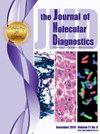用于检测新生儿干血斑中寄生虫 DNA 的 PURE-T. cruzi-LAMP 分析法的实验室间协调研究和前瞻性评估。
IF 3.4
3区 医学
Q1 PATHOLOGY
引用次数: 0
摘要
对克鲁兹锥虫垂直感染的及时诊断需要通过显微镜检测外周血中的循环寄生虫,这种方法缺乏灵敏度,而且依赖于操作者。因此,大多数受克鲁兹锥虫感染的母亲所生的孩子都需要在九个月后接受血清学检测,这有可能导致随访失败。另一种方法是利用环路介导等温扩增(LAMP)技术检测 T. cruzi DNA,这种方法具有较高的分析和临床性能,而且易于在低复杂度实验室中使用。最近,我们优化了这项技术,使用了一种超快速 DNA 提取方法,并将 LAMP 与 FTA 卡上的干血斑(DBS)相结合。该程序已在巴拉圭、玻利维亚和阿根廷的十家公立妇产医院实施,培训了 14 名技术人员。操作员的工作表现通过标准化的 DBS 检测面板(包括阴性对照和人为污染了 50 和 20 cells/mL T. cruzi 的 DBS 样本)进行了评估。对照组和 50 cells/mL 样品的一致性很好(ĸ = 0.924),所有检测面板的一致性也很好(ĸ = 0.718),甚至在检测的检测极限也是如此。一项前瞻性研究收集了 222 名新生儿出生和/或两个月时的 306 份 DBS,其中 4 例在显微镜下检测到了 T. cruzi。LAMP 检测出 8 例阳性病例,并与实时 PCR 检测结果完全一致(ĸ = 1),这表明在早期检测婴儿感染方面,LAMP 比显微镜观察具有更高的灵敏度。本文章由计算机程序翻译,如有差异,请以英文原文为准。
Interlaboratory Harmonization Study and Prospective Evaluation of the PURE–Trypanosoma cruzi–Loop-Mediated Isothermal Amplification Assay for Detecting Parasite DNA in Newborn's Dried Blood Spots
Timely diagnosis of vertical Trypanosoma cruzi infections involves microscopy-based detection of circulating parasites from peripheral blood, which lacks sensitivity and is operator dependent. Consequently, most children born to T. cruzi–infected mothers are required to undergo serological testing after 9 months, which risks loss to follow-up. Alternatively, the loop-mediated isothermal amplification (LAMP) test for T. cruzi DNA offers high analytical and clinical performance and is easy to use in low-complexity laboratories. Recently, we optimized this technique using an ultrarapid DNA extraction method combined with the LAMP in dried blood spots (DBSs) on Flinders Technology Associates cards. The procedure has been implemented in 10 public maternities across Paraguay, Bolivia, and Argentina, involving the training of 14 technicians. Operators' performance was evaluated using a standardized DBS testing panel for harmonization, including negative controls and DBS samples artificially contaminated with T. cruzi at 50 and 20 cells/mL. There was strong agreement (ĸ = 0.924) for controls and 50 cells/mL samples, and good agreement (ĸ = 0.718) across all testing panels, even at the detection limit of the test. A prospective study collected 306 DBSs from 222 newborns at birth and/or 2 months, detecting T. cruzi microscopically in four cases. LAMP identified eight positive cases and perfectly aligned with real-time PCR (ĸ = 1), demonstrating higher sensitivity than microscopic observation for early detection of infection in infants.
求助全文
通过发布文献求助,成功后即可免费获取论文全文。
去求助
来源期刊
CiteScore
8.10
自引率
2.40%
发文量
143
审稿时长
43 days
期刊介绍:
The Journal of Molecular Diagnostics, the official publication of the Association for Molecular Pathology (AMP), co-owned by the American Society for Investigative Pathology (ASIP), seeks to publish high quality original papers on scientific advances in the translation and validation of molecular discoveries in medicine into the clinical diagnostic setting, and the description and application of technological advances in the field of molecular diagnostic medicine. The editors welcome for review articles that contain: novel discoveries or clinicopathologic correlations including studies in oncology, infectious diseases, inherited diseases, predisposition to disease, clinical informatics, or the description of polymorphisms linked to disease states or normal variations; the application of diagnostic methodologies in clinical trials; or the development of new or improved molecular methods which may be applied to diagnosis or monitoring of disease or disease predisposition.

 求助内容:
求助内容: 应助结果提醒方式:
应助结果提醒方式:


